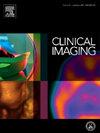Assessment of radiology resident competency in identifying conditions amenable to interventional radiology and recognition of procedural complications
IF 1.8
4区 医学
Q3 RADIOLOGY, NUCLEAR MEDICINE & MEDICAL IMAGING
引用次数: 0
Abstract
Purpose
The purpose of this study was to assess the ability of radiology residents to identify conditions that may benefit from IR intervention and recognize complications of IR procedures during a simulated emergency radiology call shift.
Materials and methods
This study utilized the Wisdom in Diagnostic Imaging Simulation (WIDI SIM) platform, an emergency imaging simulation designed to assess radiology resident preparedness for independent call. During an 8-hour simulation, residents were tested on 65 cases across various imaging modalities of varying complexity, including normal studies. We identified four cases involving conditions amenable to IR intervention or post-procedural complications that were included in simulations administered between 2016 and 2023. Cases were assessed using a standardized grading rubric by subspecialty radiology faculty, with errors subsequently classified by type.
Results
A total of 1152 scores from radiology residents were assessed on four IR cases over the course of seven years of testing. Cases included splenic trauma with pseudoaneurysm, pseudoaneurysm following renal transplant biopsy, ruptured hepatocellular carcinoma, and IVC filter complication. Analysis revealed that residents underperformed in identifying conditions amenable to IR intervention and recognizing post-procedural complications. Points were primarily lost to observational error.
Conclusions
Timely diagnosis of these conditions is imperative to prevent life-threatening complications. Our results highlighted challenges in radiology residents' proficiency in identifying these conditions. Addressing these challenges through simulation training and targeted education is essential to improve resident competency in diagnosing conditions amenable to IR intervention and recognizing post-procedural complications.
求助全文
约1分钟内获得全文
求助全文
来源期刊

Clinical Imaging
医学-核医学
CiteScore
4.60
自引率
0.00%
发文量
265
审稿时长
35 days
期刊介绍:
The mission of Clinical Imaging is to publish, in a timely manner, the very best radiology research from the United States and around the world with special attention to the impact of medical imaging on patient care. The journal''s publications cover all imaging modalities, radiology issues related to patients, policy and practice improvements, and clinically-oriented imaging physics and informatics. The journal is a valuable resource for practicing radiologists, radiologists-in-training and other clinicians with an interest in imaging. Papers are carefully peer-reviewed and selected by our experienced subject editors who are leading experts spanning the range of imaging sub-specialties, which include:
-Body Imaging-
Breast Imaging-
Cardiothoracic Imaging-
Imaging Physics and Informatics-
Molecular Imaging and Nuclear Medicine-
Musculoskeletal and Emergency Imaging-
Neuroradiology-
Practice, Policy & Education-
Pediatric Imaging-
Vascular and Interventional Radiology
 求助内容:
求助内容: 应助结果提醒方式:
应助结果提醒方式:


